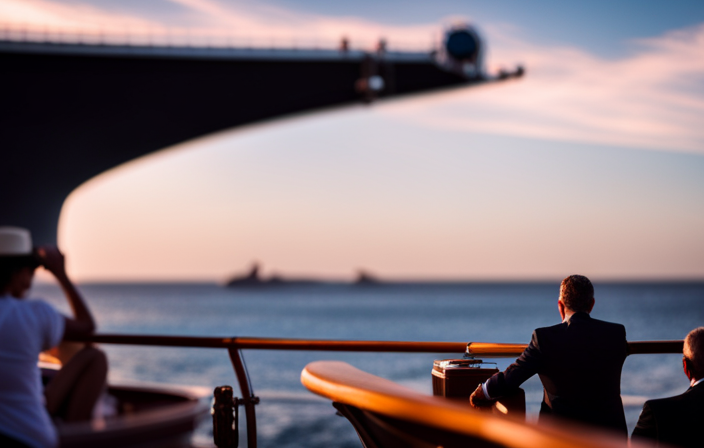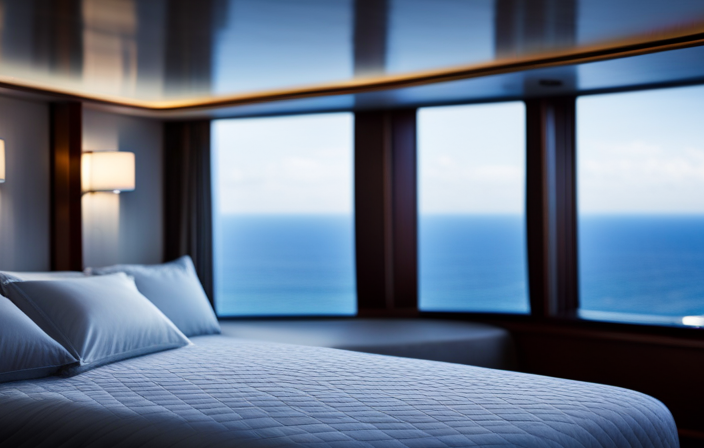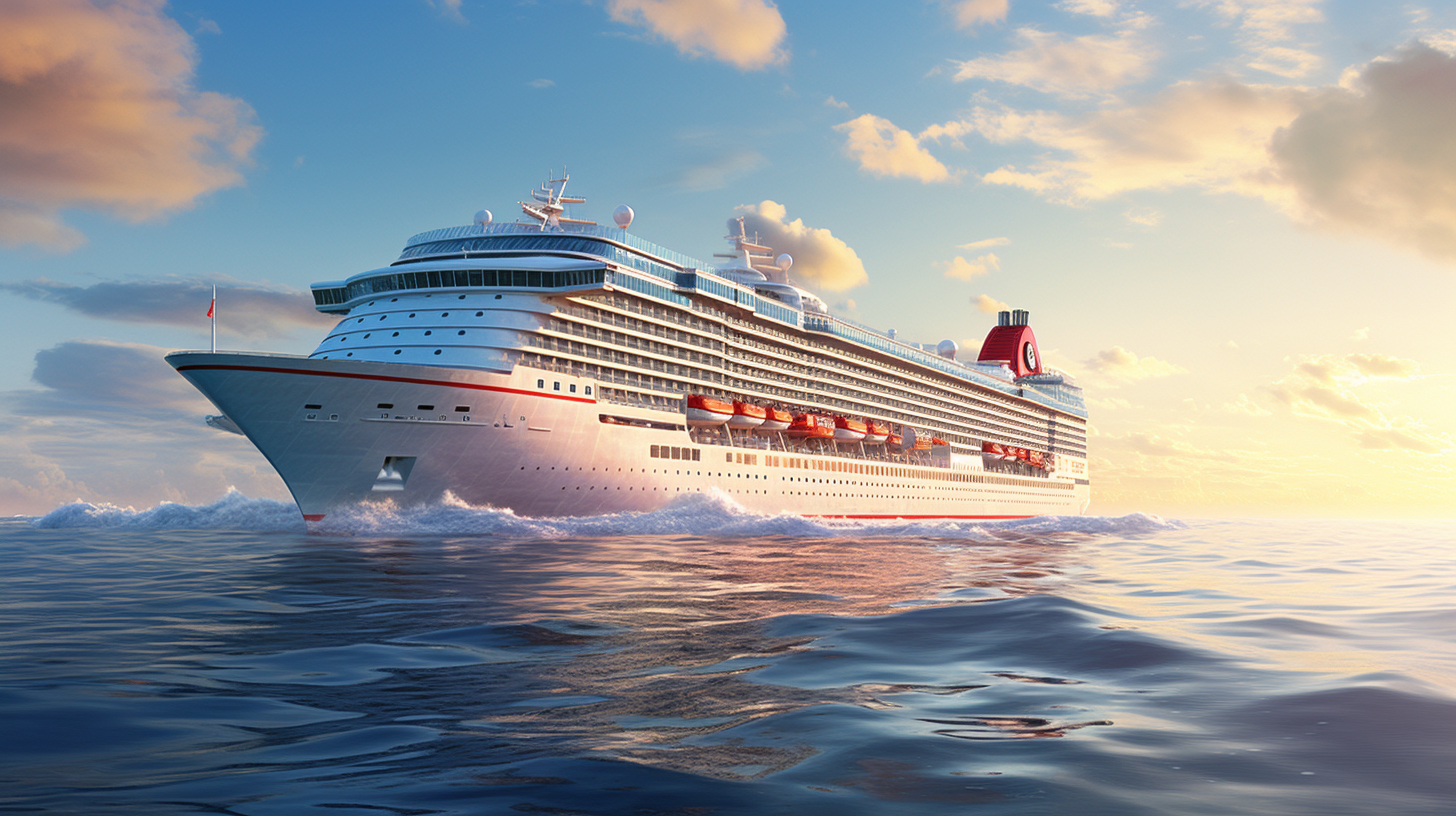As a seasoned traveler, I have always been intrigued by cruises due to the one-of-a-kind adventures they provide. The appeal of cruising lies in the opportunity to visit various ports of call during the journey. While some ports are conveniently accessible directly from the ship, certain destinations necessitate a unique transportation method called tendering to reach them.
Just like a delicate flower floating on the water, tender ports beckon with their allure and mystery. But what exactly is a tender port? In simple terms, it’s a location where larger cruise ships cannot dock directly at the pier due to shallow waters or limited infrastructure. Instead, passengers are ferried ashore on smaller boats called tenders.
In this article, we’ll dive into the fascinating world of tender ports and discover why they exist, how they work, and what advantages and disadvantages they bring to your cruise experience. So get ready to explore these hidden gems and learn all about making the most of your time in these enchanting destinations.
Key Takeaways
- Tender ports are gateways to uncharted wonders.
- They offer a variety of activities and excursions.
- Ships anchor offshore, and tenders transport passengers to shore.
- Private vehicles are usually not permitted due to limited infrastructure.
Definition and Explanation of Tender Ports
A tender port refers to a destination where the cruise ship cannot dock directly at the pier due to various reasons such as shallow waters or lack of infrastructure. Instead, passengers are transported from the ship to shore using smaller boats known as tenders. These tenders serve as a means of transportation between the ship and the port.
Tender ports offer an alternative experience for cruisers, allowing them to visit destinations that may not be accessible by larger ships. It adds an element of adventure and excitement to the journey, creating unique memories for travelers. Additionally, tender ports often provide access to picturesque islands or secluded locations that cannot accommodate large vessels.
Now that we understand what a tender port is and how it operates, let’s explore the reasons behind their existence in more detail.
Reasons for the Existence of Tender Ports
When you’re on a cruise, one of the main reasons for having certain ports that require tendering is to provide passengers with a more unique and intimate experience at select destinations. Tender ports offer several benefits for both cruise lines and passengers alike. Here are some key reasons why tender ports exist:
-
Access to remote locations: Some destinations may not have deep-water docks or infrastructure to accommodate large cruise ships. Tender ports allow cruisers to visit these remote and less crowded places.
-
Exploring smaller islands: Tendering allows access to smaller islands that cannot accommodate larger vessels, giving passengers the opportunity to explore hidden gems off the beaten path.
-
Preserving natural beauty: By using tenders instead of docking directly, cruise lines can help preserve fragile ecosystems and minimize environmental impact in sensitive areas.
-
Enhancing privacy and exclusivity: Tender ports often provide a more private and exclusive experience as they attract fewer crowds compared to mainstream port cities.
Tender ports benefit both passengers and destinations by offering unique experiences while minimizing negative impacts. Now let’s dive into how tender ports work without missing out on any exciting details.
How Tender Ports Work
Get ready to embark on a fascinating journey as we uncover the inner workings of these enchanting gateways to hidden treasures.
Tender ports are an essential part of cruising, providing access to destinations that would otherwise be inaccessible by large cruise ships. So, how do tender ports work?
When a ship anchors offshore because there is no available dock, smaller boats called tenders transport passengers from the ship to the port.
To choose which tender ports to visit, consider factors like scenic beauty, local culture, and unique experiences.
Additionally, it is important to follow tender port etiquette, such as listening for announcements about departure times and being respectful of other passengers’ time constraints.
Understanding how tender ports operate and practicing proper etiquette will help ensure a smooth and enjoyable experience.
Now let’s explore the advantages and disadvantages of tender ports.
Advantages and Disadvantages of Tender Ports
Advantages of tender ports:
- Smaller ships can access shallow or lacking docking facilities
- Ability to visit remote and picturesque locations
- Provides an intimate and exclusive experience
Disadvantages of tender ports:
- Time-consuming process of transferring passengers from ship to shore
- Dependent on weather conditions
- Limited time ashore due to logistical constraints
Despite these drawbacks, many travelers find the benefits outweigh the cons when it comes to visiting these enchanting destinations.
Now let’s explore some common destinations with tender ports…
Common Destinations with Tender Ports
Imagine yourself stepping off the ship onto the sun-kissed shores of a secluded island, surrounded by crystal clear turquoise waters and untouched natural beauty. Tender ports offer a unique opportunity to visit destinations that are not accessible by large cruise ships.
Some common destinations with tender ports include Santorini, Greece; Bora Bora, French Polynesia; and Cabo San Lucas, Mexico.
Once ashore, you’ll find an array of popular attractions waiting to be explored. In Santorini, don’t miss the iconic blue-domed churches and breathtaking views from Oia. In Bora Bora, immerse yourself in the vibrant coral reefs while snorkeling or diving. And in Cabo San Lucas, take a boat tour to see the famous rock formations at Land’s End.
When visiting these tender ports, transportation options vary from taking a local taxi or bus to hiring a private tour guide for more personalized experiences. Planning and preparation for visiting a tender port is essential to make the most out of your time ashore.
Planning and Preparation for Visiting a Tender Port
As you step onto the sun-kissed shores of a secluded island, surrounded by crystal clear turquoise waters and untouched natural beauty, it’s important to plan and prepare for your time ashore in order to fully experience the unique attractions that await you. When visiting a tender port on a cruise, there are several planning considerations to keep in mind. Firstly, check the ship’s daily itinerary to see if any excursions are offered at the port of call. If not, research local attractions or activities ahead of time and make a list of must-see places. Secondly, consider transportation options from the ship to the shore. Typically, cruise ships use tender boats to transport passengers from the ship to the port when it is not possible for them to dock directly. These small boats can accommodate a limited number of passengers at a time and may require advance reservation or ticketing. Being aware of these planning considerations will ensure that you make the most out of your visit to a tender port.
Transitioning into the subsequent section about ‘boarding and disembarking the tenders’, it is essential to understand how this process works smoothly without causing any inconvenience for fellow travelers.
Boarding and Disembarking the Tenders
When stepping onto the tender boat, take a moment to appreciate the gentle sway of the vessel and the anticipation in the air as fellow travelers eagerly await their adventure ashore.
The boarding process for a tender port is quite straightforward. Cruise staff will guide passengers to board the tenders in an organized manner, ensuring everyone’s safety. It’s important to follow any instructions given by crew members and be mindful of safety precautions, such as holding onto handrails while on board and wearing appropriate footwear.
Once aboard, find a comfortable seat and enjoy the scenic ride to shore.
As we transition into discussing activities and excursions at tender ports, it’s worth noting that these ports offer unique opportunities for exploration and discovery beyond what you might experience at traditional docked ports.
Activities and Excursions at Tender Ports
Get ready to embark on a thrilling journey filled with hidden treasures and unforgettable experiences as you set foot on the gateway to uncharted wonders.
Tender ports offer an array of activities and excursions that cater to all interests. Whether you’re a history buff or an adventure seeker, there are sightseeing options that will leave you in awe.
Explore ancient ruins, stroll through charming villages, or marvel at breathtaking landscapes. And don’t forget to indulge in the local cuisine! Sample delicious seafood dishes, savor exotic spices, and taste traditional delicacies that will tantalize your taste buds.
From cultural tours to adrenaline-pumping adventures, tender ports have it all. So get ready for an exciting exploration of new horizons and make the most of your tender port experience by following these helpful tips…
Tips for Making the Most of Your Tender Port Experience
Maximize your experience at the tender port with these helpful tips:
- Plan ahead and research activities and attractions at the port. Prioritize what you want to do and don’t miss out on must-see sights.
- Be mindful of the tender schedule. Try to get off the ship early to beat the crowds.
- Book excursions through the cruise line for priority tender access.
- Allow flexibility for unexpected delays or changes in plans.
By following these tips, you can truly maximize your tender port experience and create unforgettable memories exploring new places.
Now that we’ve covered how to make the most of your tender port experience, let’s move on to frequently asked questions about tender ports.
Frequently Asked Questions about Tender Ports
Now that you know some useful tips for making the most of your tender port experience, let’s dive into some frequently asked questions about tender ports.
1) How does the cruise ship tendering process work?
Well, when a ship is too large to dock directly at a port, it anchors offshore and smaller boats, known as tenders, transport passengers to shore.
2) Are there alternative transportation options available at tender ports?
Absolutely! Depending on the location and availability, you may have options like water taxis or local ferries to explore different areas around the port.
3) Can I use my own transportation at a tender port?
In most cases, private vehicles are not permitted at tender ports due to limited infrastructure. However, you can always check with your cruise line for any exceptions or special arrangements they might offer.
So get ready to embark on an exciting adventure as we unravel more about tender ports and their fascinating elements!
Frequently Asked Questions
What are some common activities and excursions offered at tender ports?
At tender ports, you can enjoy an array of exciting activities and excursions. From thrilling water sports like snorkeling and kayaking to immersing yourself in the local culture through guided tours and visits to historical landmarks. Did you know that over 90% of cruise passengers participate in onshore activities?
How long does it usually take to board or disembark a tender?
Boarding and disembarkation times for tenders can vary depending on the size of the ship and the number of passengers. Generally, it takes around 15-30 minutes to board or disembark a tender.
Are there any restrictions on who can board the tender, such as age or mobility limitations?
Age is just a number when it comes to boarding the tender. As for mobility limitations, they won’t stop you either. Cruises ensure everyone has access, so anyone can embark and disembark without restrictions.
Can passengers bring their own food or drinks on the tender?
Passengers are not allowed to bring alcohol or food on the tender. There are restrictions on bringing outside items for safety and security reasons. Cruise lines provide plenty of options for dining and refreshments onboard the ship.
Are tender ports accessible for passengers with disabilities?
When it comes to accessibility concerns at tender ports, cruise lines prioritize passenger needs. Accommodations are available for passengers with disabilities, ensuring they can comfortably and safely enjoy the port experiences.
Conclusion
In conclusion, tender ports on a cruise are like hidden gems waiting to be discovered. They offer a unique and intimate experience, allowing you to explore beautiful destinations that larger ships cannot reach.
Just like a butterfly emerging from its cocoon, tender ports unveil their beauty and charm as you step onto the tender boat.
So embrace the opportunity to visit these enchanting ports, immerse yourself in new cultures, and create unforgettable memories. Bon voyage!










